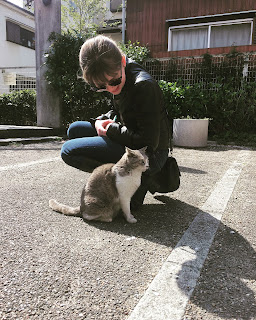But did you know that there is, in fact, a "second Harajuku" in Tokyo?
Several stops north of Ikebukuro on the Yamanote Line is Sugamo, an area colloquially known as the "Harajuku for grannies." Sugamo is a shopping district where everything moves at a slower pace. The main street is lined with stores, many of them specializing in things that, well, old people would need or want: specialty Japanese ingredients, visors, canes, and special red underwear. (I'll come back to that in a moment.)
One really interesting thing I noticed walking up the street was how accessible each of the shops was. All of them were wheelchair and walker-friendly: there were no steps and the aisles were wide and free of obstructions. The boulevard, too, was wide and easily designed for easy meandering.
Along with my friend Frances (who initially proposed this excursion) I stopped to get one of the region's specialty foods, shiodaifuku, a slightly salty rice cake filled with red bean paste (in this case unsweetened). Sounds weird, tastes delicious.
Another thing Sugamo is known for is Koganji Temple. Koganji Temple is a Buddhist temple famous for its Togenuki Jizo statue, which is said to have healing powers. People line up to pour water and wash, with a cloth, the Jizo statue and then press the cloth to their injury or affliction which will then, presumably, be magically healed!
Now, back to the red underwear.
At the far end of the shopping street is a bright red store: red awning, red signs, and red products of all varieties. This is Maruji, a shop whose products are all designed to promote good luck and prosperity. Red underwear, in particular, is supposed to ward off disease and promote good health and energy in general. The storefront is eye-catching, if nothing else!
From Sugamo, Frances and I walked even further north to the Kyu-Furukawa Gardens.
To our pleasant surprise, there was a large English-style manor built on the grounds. The building was designed by English architect Josiah Condor who apparently designed multiple public buildings in Tokyo during the Meiji Period (1868-1912).
We weren't allowed to go into the house (we missed the daily predetermined tour times) but the guide who took us on a tour of the expansive Japanese garden told us that the first floor rooms were all designed in Western-style but the second floor, where the Furukawa family would have actually lived, was built in traditional Japanese style with tatami mats and shoji screen doors. So the first floor was for "showing off" how enlightened and wealthy you were, while the second floor was for comfortable living. You really can't tell that's the case from the exterior, however, which I think is a fascinating dichotomy.
Also, I made a cat friend while walking around the backstreets of the neighborhood!








Comments
Post a Comment